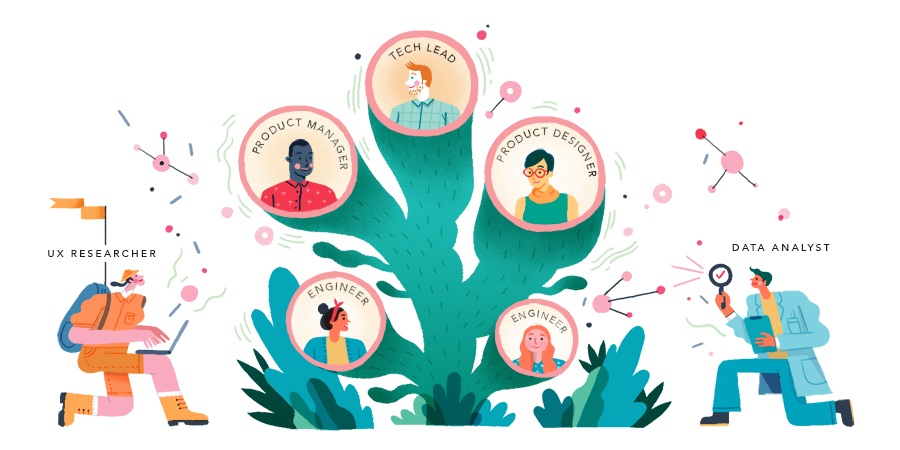
These are the things we know to be true.
If cupcakes find their way into the kitchen, they disappear so quickly that they must get pulled into some kind of wormhole (that’s the only explanation). We’ll never be able to agree on which office dog is the cutest. And most importantly, our success as a product team rests on three things: our customers, our code, and our culture.
This is about the last of these: how we as a product team work together, how our teams are structured, and what we believe. We’re trying to build a company that makes great software - software that’s reliable and fast and secure, that solves real problems, that feels like it was made by humans with personalities who care about design and craftsmanship. And we’re trying to build a company where the people who make that software enjoy doing it. Our culture is the key to making these a reality.
This is us.

Well, some of us. That’s because some of us work in Cambridge. Some of us work in Dublin. A few of us work remotely. Our team is made up of engineers, designers, product managers, UX researchers and writers, and data analysts.
And while we’ve grown and changed a lot over the years, there are a few principles that have held true, our lighthouses in the storm. Of course, these things aren’t unique to HubSpot. We don’t have a monopoly on wanting to solve for our customers, or on giving the people on our team the autonomy to build products the way they think is best. But the combination of these things is what makes us, well, us.
So these are the things we know to be true. HubSpotters should feel ownership over the work they do and accountable for the success of their products. Quick iteration is the best way to build good software. Continually investing in our platform lets us focus more on our customers and less on solving the same problems over and over again. And that the only way we can build good software is by growing together.
 Imagine you took a rockstar product team and locked them in a conference room (stay with us). You then gave them a problem to solve and all the time in the world to design a perfect system and create beautiful, well-architected code. We’d be willing to bet that when they finished their work and unveiled it for all the world to see, they would almost certainly have built the wrong thing for their customers.
Imagine you took a rockstar product team and locked them in a conference room (stay with us). You then gave them a problem to solve and all the time in the world to design a perfect system and create beautiful, well-architected code. We’d be willing to bet that when they finished their work and unveiled it for all the world to see, they would almost certainly have built the wrong thing for their customers.
The reality is that you can't figure out the right thing in a vacuum; the only way to find it is to talk to customers, and often. This means that, here at HubSpot, designers show their mockups to customers at every stage of the design process and get feedback. Engineers put together proof-of-concepts and get feedback. Product managers beta test with small groups of intrepid customers and get feedback. We believe that mockups, code, and assumptions that sit on your laptop or in your head for weeks on end are useless. Get them out there and get feedback. No one gets things perfect on their first try - not even the most brilliant design, engineering, and product minds out there.
This means that designers spend most of their time in Sketch. Most engineers spend nearly all of their time building software (in fact, we deploy to production over 2,000 times per week). We trust our teams to spend their time the way they think is best. Jen, one of our tech leads, summed up that trust pretty well:
Deploying code is second nature; you do it so many times a day it feels like business as usual. It’s only when you talk to people at other companies that you realize not every place works like that. To get

Jen Huang
Tech Lead
One of the keys to rapid iteration is being able to minimize the distance between the team and the customer. Our platform is the key to making that dream a reality.
HubSpot is a scale-up, which means we’re no longer a small company, but that we also have  We’ve invested hugely in our platform and the teams that build it. This means that we’ve created world-class build and deploy tools, automated redundancy
We’ve invested hugely in our platform and the teams that build it. This means that we’ve created world-class build and deploy tools, automated redundancy
We invest in these things because our platform is a multiplier. Instead of agonizing over how to design a date picker or which datastore to use, teams can focus on understanding customers and solving the problems they know best. In fact, because of the power of our platform, many teams at HubSpot have taken on missions and markets inhabited by entire companies many times their size. Building on our platform turns your 5-person team into a 75-person team. This horizontal scaling means that our small, autonomous teams are able to replicate the speed and impact of a startup inside of the larger organization.
 At many companies, the product manager is the head of the team. They tell the team what to do and the team does it. Product managers hand requirements to developers. Product designers throw mockups over the wall. Developers pass their code off to a QA team to test or an operations team to deploy (we have neither here at HubSpot). Executives micro-manage the team’s
At many companies, the product manager is the head of the team. They tell the team what to do and the team does it. Product managers hand requirements to developers. Product designers throw mockups over the wall. Developers pass their code off to a QA team to test or an operations team to deploy (we have neither here at HubSpot). Executives micro-manage the team’s
This doesn’t work (at least, not for us) because none of these things create ownership. At HubSpot, we build things because we’ve done our research and we understand the business problem, because we believe that our solution will help solve our customers’ pains, and, frankly, because we care about the people we’re building software for and about building the best products we possibly can.
In short, we believe that people build better products when they feel deep ownership over them.
We do these things in small, autonomous teams. We like small teams (for us, that means around 5 people) because they can move quickly. They communicate faster and get buy-in more easily. We don’t need huge meetings to solve problems or make decisions (well, usually - since we’re being honest). If anyone on the team has questions, they turn to the person to their right or their left and figure things out in real time. And teams are autonomous because they wholly and absolutely own a part of the product.
We have about 40 of these teams. Some of them are focused on building marketing, sales, and customer success tools that help our users grow their businesses, while others are focused on building the tools that make our teams here more successful.
Most of our product teams look something like this:

We spend a ton of time making sure that teams have the right people on
Each Wednesday morning (or afternoon, if you’re in Dublin), we have a one-hour meeting called Tech Talk. Each week, the speaker is different - it could be a front-end developer on our reporting tools, or the engineer working on HBase availability, a designer talking about the jobs-to-be-done framework, or our product editor-in-chief. Anyone can
We expect everyone to be a leader and a learner, no matter what your title or role might be. And if you walk through the halls of HubSpot, you’ll see it - engineers perched on each others’ benches talking about the best ways to make sure our systems can scale under load, or designers and product managers whiteboarding solutions in conference rooms or lounges.
 That’s because we’re serious about helping people grow their skills and their careers. People often take on new missions, whether that’s a new stack or a new
That’s because we’re serious about helping people grow their skills and their careers. People often take on new missions, whether that’s a new stack or a new
And we want to see our community grow too. HubSpotters often volunteer with Hour of Code and Girls Who Code. We noticed that many undergraduate women had less experience building software outside of class than their male counterparts, so we created our own Web App Workshop geared towards giving them the foundation to build those skills. We’ve created programs and events to help
It’s not just our team that obsesses over culture. All of HubSpot does. If we’ve sparked your interest, take a look at the HubSpot Culture Code, built and maintained by one of our co-founders, Dharmesh.
Fun fact: You can email Dharmesh your thoughts about the culture code. He reads every single one.
If this sounds like the kind of place you’d like to build products, why not join us? We’re hiring, and we’d love to hear from you.